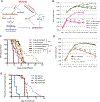Mating induces shrinking and death in Caenorhabditis mothers
- PMID: 24356112
- PMCID: PMC6719292
- DOI: 10.1126/science.1242958
Mating induces shrinking and death in Caenorhabditis mothers
Abstract
Interactions between the germ line and the soma help optimize reproductive success. We discovered a phenomenon linking reproductive status to longevity: In both hermaphroditic and gonochoristic Caenorhabditis, mating leads to female shrinking and death, compressing postreproductive life span. Male sperm induces germline- and DAF-9/DAF-12-dependent shrinking, osmotic stress susceptibility, and subsequent life-span decrease, whereas seminal fluid induces DAF-16-dependent life-span decrease and fat loss. Our study provides insight into the communication between males and the female germ line and soma to regulate reproduction and longevity, revealing a high-reproduction, low-life-span state induced by mating. Postmating somatic collapse may be an example of the sexually antagonistic influence that males in many species exert on female behavior to maximize their own reproductive success.
Figures




Comment in
-
Development. Chemical warfare in the battle of the sexes.Science. 2014 Jan 31;343(6170):491-2. doi: 10.1126/science.1250174. Science. 2014. PMID: 24482469 No abstract available.
-
Sexual conflict: male control of female longevity.Curr Biol. 2014 Mar 3;24(5):R196-8. doi: 10.1016/j.cub.2014.01.044. Curr Biol. 2014. PMID: 24602884
References
Publication types
MeSH terms
Substances
Grants and funding
LinkOut - more resources
Full Text Sources
Other Literature Sources
Miscellaneous

